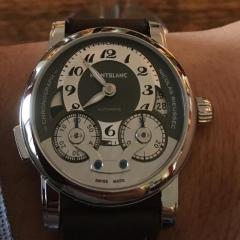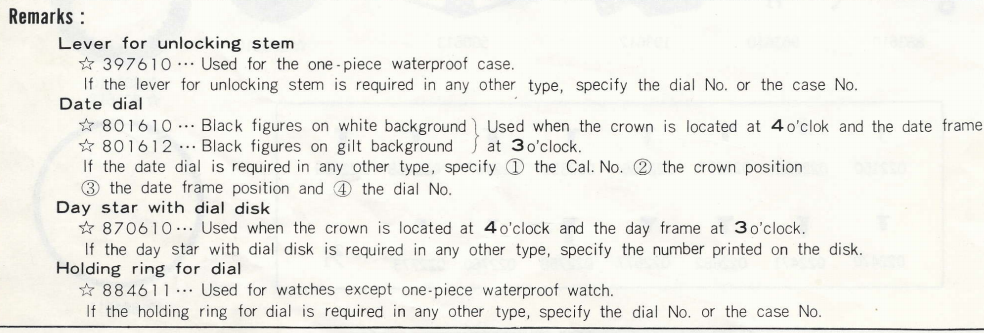Leaderboard
Popular Content
Showing content with the highest reputation on 10/15/19 in Posts
-
This will be of interest to military watch collectors: Obituary Guardian 14/10/19 written by Jon Silverman : " Founder of the Cabot Watch Company, whose stopwatches were used by officials in the 1983 FA Cup final" "My father-in-law, Raymond Mellor, who has died aged 95, was a considerable figure in the world of clocks and watches. In 1962 he set up the London office of the Swiss-based Hamilton Watch Company, and later, when it was taken over by an American concern, he established his own firm, the Cabot Watch Company( named after one of his heroes, the 15th-century explorer John Cabot), whose distinctive CWC stopwatches are still in circulation. In 1983, Cabot supplied the timepieces with which the referee and linesmen officiated in the FA cup final between Manchester United and Brighton .Benefiting from complimentary tickets,I watched the game(as a United supporter) with passionate interest while,next to me, Ray's attention wandered between his own watch and the actions of the referee, on edge lest the timekeeping be found at fault. Ray was born in Chiswick, west London, the son of Polish Ukrainian emigres, Elizabeth(nee Bulinsky) and Nachum Chmelnitzsky (who changed his name to Norman Mellor when he became a British citizen). Norman later worked for the BBC. Ray went to Harrow county school but left at the outbreak of the second world war and through family connections, joined a tug company in Bristol. At the age of 16 Ray was running the company's offices at the Avonmouth Docks and, at night, firewatching on the ships at the height of the blitz. Later he joined the merchant navy, working as a purser on the Cunard troop ships, including the Queen Elizabeth, during the battle of the Atlantic. At the end of the war he returned and met Phyllis Canter on the 183 bus. They married in 1948. By then Ray had had enough of the sea, and joined a chain of cutlery and watch shops owned by Phyllis's uncle, rising to be joint manager before joining the Hamilton Watch Company. Ray had a fine bass voice and, at one time, contemplated a career as a professional singer, but realised he would probably not make it to the top. However, in 1962 he joined the New Philharmonia Chorus and sang with them for 12 years, in the UK and abroad, under most of the great conductors from Klemperer to Giulini and sharing the stage with such singers as Birgit Nilsson and Jon Vickers. Ray was master of the Clockmakers Company in 1987-88, chairman and later president of the British Horological Institute, chairman of the watch and Clock Importers Association and a fellow of the Royal Society of the Arts. Phyllis died in 2000. Ray is survived by their children, Jackie and Simon, and four grandchildren, Alex, Daniel, Phoebe and Imogen. Jon Silverman. "1 point
-
Your link is very misleading and the description is not quite appropriate. Scrubbing isn't exactly the proper word and cleaning isn't exactly valid either. Unfortunately you have to read almost to the very end to get this sentence that I'm exactly quoting " To mount the balance, you can place it in a balloon chuck in a lathe or set it in a pivot polisher ". Then I'm attaching a sort of helpful link to a YouTube video. The video is not entirely correct either sort of but does show a balloon Chuck. So a balloon Chuck allows you to hold the balance wheel in the lathe with only the pivot sticking out so you can work on it. Working on it would mean polishing which is exactly what is described that your link. Possibly reshaping the pivots but hopefully not as aggressive as in the video. Or Reshaping the end of the pivot. Simplistically it's a way of holding a balance wheel to allow you to work on the pivot without destroying the rest of the balance wheel. Then yes if it's a really big American pocket watch you can usually leave the hairspring on as it doesn't seem to bother it. https://youtu.be/9K0-DVmZjrg In this next link scroll down to "Joseph School of Watch Making" Click on "Unit 4 - Burnishing Balance Pivots" This also shows the balloon Chuck. https://www.mybulova.com/vintage-bulova-catalogs So now go back to the original link read carefully instead of heavy burnishing instead you're going to polish the pivot. So sometimes aggressive burnishing is not required only polishing.1 point
-
Hi. I'm looking into having a go at disassembly and hopefully rebuild a movement. I've came across a Ronda 1113 are these good for a beginner to try with or any suggestions? Budget low. Thank you1 point
-
Therefore, see that you always have a magnetic strip around, to find the small pieces on the ground again. https://www.toolspecialist.be/688-flexible-magnetic-strips-2-150mm-e-magnets-688?___store=be&gclid=EAIaIQobChMIopfQv7We5QIVguR3Ch34KQ4gEAQYECABEgJLvfD_BwE And don't forget them to demagnetize afterwords.1 point
-
Further on from my post I highly recommend that before replacing a balance staff test on a few scrap movements or balances. Its one of those jobs that looks simple but if you get it wrong there is no way back. I speak from experience. Marks vids are excellent and notice once fitted the testing procedure is also important.1 point
-
1 point
-
Three for two offer. Three no-name Chinese automatic movements for the equivalent of 73 pence each - One with an obviously damaged balance, and the other two in unknown condition, with a scruffy fake blue Rolex dial thrown in for good measure. I couldn't resist. Since they came from a UK seller, the arrived a couple of days after I parted with the dough. I had a spare couple of hours, so I stripped them all down last night and made two fully functional Chinese standard based automatics from the bits. I may have a crack at repairing the damaged balance, as it simply has an entertainingly twisted hairspring, which I may be able to puzzle back into a sane configuration. There were issues on the other two movements. One had a damaged ball race (and the ball bearings instantly escaped when I took off the auto-winder). The other (the one with the Faulex blue dial on the left of the picture) had a missing jewel, a mangled canon pinion, and the center wheel was in two parts. Presumably this one had been dropped. Working on them was remarkably easy, although in my exuberance while stripping them down, I did manage to launch one date spring into a parallel dimension, but this wasn't a worry as there was a spare. I will take a crawl round the carpet with a magnet at some stage today, to find it, before it ends up in the vacuum cleaner. Since I had enough bits to make two complete movements, that was what I settled on. I also found a second winding stem in my spares stash, so I have an almost complete set of spares, and two fully operational automatics for the princely sum of £2.20 My next problem is going to be ... what to do with them.1 point
-
Don't fear it, just respect it. Its flammable, but that's not a problem if you remember that. Get some small glass jars with lids that seal and use it. RMD1 point
-
For a newcomer one thing to be careful of is squeezing the tweezers too hard when holding a small part, quite often the part will 'ping' off at great speed involving much searching. Basic stuff, but you don't always think of it at the time.1 point
-
Hi Clockboy has explained it very well. The K&D tools work well enough in the demonstrations if used properly, I would advise watching a few of these on The tube just to get familiar with its use. The method is that when fitted tio the staking tool and screwed down it supports the arms of the balance on to the stake avoiding distortion. Watch the videos before having a go.1 point
-
Hi Should be ok for practise although the calender work is a bit extra for training, as long as its a disposable movement should anthing go wrong. I have enclosed the tech sheet for that model, might help as you re assemble the movement. all the best 3897_Ronda RL 1013, 1113 (RL), 1213, 1313_Smaller.pdf1 point
-
Old movement probably been sitting idle for long time, I soak the movement in naphta for a day or two or apply penetrating oil which reduces risk of breaking screws . Take extra care with pin pallets. Not worth buying parts for, I got some parts to it.1 point
-
Whatever method is used to remove a staff it is imperative not to distort the balance or elongate the hole. The most trusted method used for many years was to remove part or all of the staff on a watchmakers lathe. However there are other methods which involve pushing the old staff out either with a Platax tool or a staking set. These methods can be problematic especially with vintage watches as the metal used was very hard. Also when using this method you must support the cross section of the balance to eradicate any distortion. There is a tool that can be purchased for this for staking sets. Personally I remove part of the staff on my lathe and then push it out to eliminate any mishaps. Here is a previous post:1 point
-
Yes I have had this issue in the past. The day & date disks look the same but when fitted do not align with the dial window. I have had some that are just a tiny bit out which is annoying. Luckily I picked up a job lot of dial & date disks off eBay a few years ago and have been lucky to find ones that eventually fit.1 point
-
1 point
-
Great job! I is it a stainless steel case or base metal? Also does the crown screw-down? Anilv1 point
-
1 point
-
A toothpick could bend the pivot. Pith Wood is the best. Sent from my iPhone using Tapatalk Pro1 point
-
Watchmaker - Again - many thanks! I think I should be well covered for parts to get this resolved. There is a little more to the story - which you may enjoy. The watch who's ratchet wheel screw broke - is an almost identical copy of a watch that means a lot to me (sentimentally). I found it on eBay in NOS condition and purchased it so that I would have a spare part of everything for the watch. The new one was so beautiful that I decided to wear it (some) - since there is no sentimental attachment to the new one. But it does remind me of the watch near and dear to me. Which, by the way is also in mostly excellent condition for a watch of it's age. I should post pictures of the two so that you can see them. The one I recently purchased is completely amazing. It came in the original box, with tags and the original strap. Not unworn, but almost. She's a beauty - and so is the one I have had for decades. -Paul1 point
-
1 point
-
I usually clean vintage watch parts in lighter fluid with an art brush. Then I finish it off by tapping the pivot ends with pith wood. Never had an issue. I did look up the method in the web and it would be ok if you didn’t use the lighter fluid at all. Sent from my iPhone using Tapatalk Pro1 point
-
Double check your lift angle. I think the poljots are in the 42 to 46 degree range.1 point










